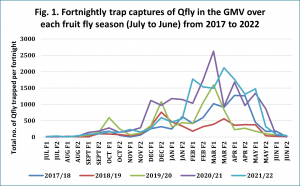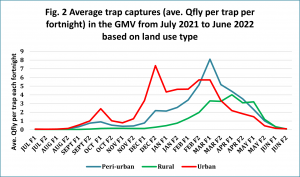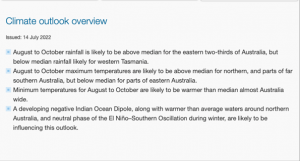This information has been commissioned by the Goulburn Murray Valley Area Wide Management Fruit Fly Program and is funded by the Victorian Government. Use of this material in its complete and original format, acknowledging its source, is permitted, however unauthorised alterations to the text or content is not permitted.
August fruit fly snapshot
Queensland fruit fly trappings have dropped as a result of traps not being as effective in the winter
- Significant Goulburn Murray Valley rainfall occurred during autumn and winter – which promotes winter survival of fruit fly in warm locations near the house in urban sites, packing sheds and other heated outhouses on rural properties
- Overwintering Queensland fruit fly will cause serious outbreaks next fruiting season if not controlled
- Practicing orchard hygiene is essential in stopping the spread and includes:
- Remove and use or destroy nearby fruit left on trees during winter in the orchard and house yards
- Pick up and destroy fruit that is on the ground
- If you see fruit on Crown land, creek banks, abandoned premises or roadsides let Council or the Regional Fruit Fly Office know
- Remove fruiting plants you no longer need
- Use fruit fly traps to assess if fruit fly are present
- Check any fruit that is near your orchard for signs of fruit fly – sting marks on the fruit surface, softening patches in the fruit flesh, eggs and or larvae in fruit
- Ensure you have access to baits and approved pesticides for Queensland fruit fly control if trap numbers get too high
The impact of winter activity on fruit fly
The number of Queensland fruit fly trapped across the Goulburn Murray Valley region during June and July 2022 dropped to the lowest this season so far. This seems like good news because it implies that the cold weather is impacting on their survival but it is likely that the cold weather will reduce the numbers of immature fruit fly (eggs, larvae and pupae) but not necessarily the adults. Queensland fruit fly adults are still being trapped.
The decline in the number of fruit fly trapped is not due to flies dying out but to the fact that it is too cold for Queensland fruit fly to be attracted to the lures inside the traps. In fact, it is generally too cold for flies to move at all as Queensland fruit fly can’t fly at temperatures below about 13°C or walk below about 2°C to 5°C.
At times during the day in some specific locations across the region, Queensland fruit fly may be able to move as temperatures are not even over the whole of the Goulburn Murray Valley. Warm microclimates exist across the landscape, allowing fruit fly if present to move around even if it is just for a short time. This is the reason why a number of Queensland fruit fly were trapped in the Goulburn Murray Valley in the last two weeks of June 2022 – a total of 46 flies from a trapping grid comprised of 350 traps (Fig. 1).
Many of the Queensland fruit fly captured in the Goulburn Murray Valley during June 2022 were from rural and peri-urban sites where, at that time, most of the host fruits are cropping in abundance (Fig. 2). Based on past observations from the Goulburn Murray Valley fruit fly trapping grid this is normal.


A note of caution needs to be added here as the greater the number of flies surviving the previous summer and autumn the more that will survive the winter by finding warm refuges. These flies will essentially be invisible at this time of year and may be present in very high numbers. Dense, evergreen trees like lemons are favoured winter refuges. If you have lemons and had fruit flies in your fruit last season, try putting a male or female fruit fly trap or two nearby to check if these pests are starting to move.
The weather is beginning to warm up with temperatures expected to be higher than the August average according to the Bureau of Meteorology’s Australian Climate Outlook August 2022. This suggests that spring activity of Queensland fruit fly may commence earlier than usual.
It is recommended that growers and home gardeners start purchasing traps, baits, nets and approved pesticides and commence setting up fruit fly management programs for their property.
Fruit fly hot spots
As of the end of the first week of July 2022 there were no trapping sites in the Goulburn Murray Valley region with Very High Queensland fruit fly risk. There were 6 sites that were classified as of High risk. These sites trapped a maximum of 5 to 13 flies in one fortnightly period from 14 June to 7 July 2022 and because of their proximity to commercial horticulture that could be at risk to Queensland fruit fly they were classified as High risk.
Table 1. Number of Goulburn Murray Valley trapping sites with varying levels of Queensland fruit fly hot spot risk
| HOT SPOT RISK | NO. OF SITES |
| VERY HIGH | 0 |
| HIGH | 6 |
| MODERATE | 31 |
| LOW | 16 |
| ZERO | 341 |
Table 2. Localities with High Queensland fruit fly hot spot risk for 14 June 2022 to 7 July 2022
| LOCALITY | NO. OF SITES |
| ORRVALE | 2 |
| SHEPPARTON EAST | 1 |
| SHEPPARTON URBAN | 1 |
| TATURA RURAL | 1 |
| TOOLAMBA | 1 |
August activity and movement
Adult flies will start to wake up from August following their winter down-time – a type of hibernation where they just hang on until it’s warm enough to fly and mate. Dense, evergreen trees like lemons and loquats are favoured winter refuges. The weather is starting to warm up, in patches at least, so adult flies in those areas are now looking for carbohydrate and protein: carbohydrate for energy and protein for sexual maturity because they’ve used up most of their reserves to survive winter. Carbohydrate can come from flowers (nectar) and protein from yeasts, fungi and bacteria growing on branches.
What can be done in home gardens?
Flies may have the opportunity to mate in August if it’s warm enough. Mating occurs at dusk if it’s 16˚C or higher. In the case there are areas where higher temperatures are reached flies will mate and lay eggs into fruit one or two days later.
Look out for black marks and soft spots on early ripening fruit that may indicate fruit fly stings. If you cut suspect fruit open and hold it up to the light you may be able to see eggs and young larvae glistening in the fruit pulp. Loquats, apricots and winter citrus are the main culprits right now.
If you have stung loquats or late-hanging autumn fruits (like pomegranates, quinces and apples) pull them off, or rake them up and feed them to the chooks or destroy them in plastic bags or by deep burial. Fruit fly effected fruit must NOT be placed in the compost heap where its warmth and humidity provides one of the best spots for them to survive – not die.
If you have lemons and had fruit flies last season try putting a male or female fruit fly trap or two nearby to check if flies are beginning to move and become active.
Other useful tips for home gardeners include planting out tomato seedlings or grafted plants now in a warm spot so you can pick ripe tomatoes before Christmas and avoid harvesting during January and February which are typically peak months for fruit fly activity. Cherry and Roma type tomatoes are a little more resistant to fruit fly attack than larger, softer, more wrinkled tomato varieties.
What can be done in commercial orchards?
- Hygiene – the most important pre-spring activity for commercial orchards
It is highly recommended that commercial growers initiate a crop checking schedule in August by looking in and around the orchard (home gardens, feral fruit on creek banks and roadsides and nearby abandoned orchards) for fruit that may act as hosts for the coming season’s fruit fly populations. Look out for black marks and soft spots on early ripening fruit that might indicate fruit fly stings.
If you find unwanted fruit pull them off, or rake them up and feed them to the chooks, destroy them in plastic bags, or by deep burial or by slashing/mulching fruit on the ground.
- Make sure you have supplies of fruit fly monitoring and control material for immediate use
Fruit fly traps are an ideal way of determining whether or not Queensland fruit fly is present in your orchard or near the house. It is recommended that traps are deployed all year round. You should move traps out of deciduous orchards in the winter to areas where it is warmer and where there are evergreen plants as this is where Queensland fruit fly will seek refuge from the cold over winter. It is highly advisable to place a number of female-biased traps in evergreen plants (e.g. lemon tree) that are situated near the house, packing shed or other relatively warm position.
Fruit fly baits are the best method for controlling fruit flies before their populations get too big to handle this way. If you start detecting fruit fly in your traps or find infested fruit in or near your crop, you should start bait applications as per the label.
If Queensland fruit fly gets out of hand you may need to use pesticide cover sprays. Staff from your produce store can assist in making the best decisions on pesticide use. It is important that the selected pesticide has APVMA approvals on their label and label instructions are followed.

Queensland fruit fly can survive the winter in the GMV and do so as adult flies. Fruit fly eggs, larvae and pupae that are in fruit or in the soil after mid-April generally will not survive the winter in the GMV unless they exist in spots where a warm microclimate persists. If they can find refuge from cold, wind and rain adults will survive the winter. Once they find refuge, they will need access to water although they can survive several days without it at this time of year. Morning dew is usually sufficient for survival over the winter.
Rain, as a source of water, is not an important issue for fruit fly at this time of year but rainy spells in winter generally involve warmer than usual days and this facilitates a higher level of survival.
The Bureau of Meteorology outlooks for August 2022, based on data from 1981 to 2010 and current weather modelling, indicate:
- A 65% to 70% chance that maximum temperatures, through August 2022, will be higher than average. Therefore, it is likely that maximum daily temperatures will exceed the mean maximum temperature for August of around 12˚C to 18˚C in the GMV. These temperatures are quite OK for fruit fly survival and means there will be decreased adult fruit fly die-off, more males entering traps in August than is normal and more adults surviving the winter into the spring.
- A 70% to 75% chance that minimum temperatures, during August 2022, will be higher than average. So, there will probably be little change in the average minimum temperature for August of 3˚C to 6˚C daily minimum in the Goulburn Murray Valley. These temperatures, especially if they are higher than normal, as the Bureau of Meteorology predicts, will not impact adversely on Queensland fruit fly adult survival.
- Around a 70% chance that August 2022 rainfall will be higher than average – therefore, it is likely that there will be more rainfall than the usual 25mm to 50mm expected during August 2022 in the Goulburn Murray Valley. This scenario will not normally impact on fruit fly survival adversely, but winter rainfall leads to higher than normal minimum temperatures which encourage fruit fly survival. It may also promote early set of fruit which could become an early target for Queensland fruit fly. This could increase the numbers produced in the first generation of spring.
Goulburn Murray Valley Area Wide Management Fruit Fly Program
For assistance in managing Queensland fruit fly, contact the Project Coordinator at the Goulburn Murray Valley Fruit Fly Office by phoning (03) 5871 9222 or email gmvfruitfly@moira.vic.gov.au.
This report was produced and supplied by Janren Consulting Pty Ltd for the purpose of the Goulburn Murray Valley Fruit Fly Program. The Goulburn Murray Valley Fruit Fly Area Wide Management Program is supported by the Victorian Government.
